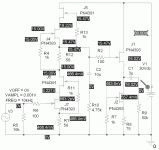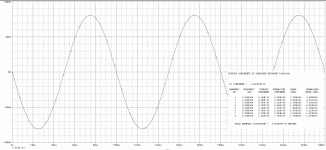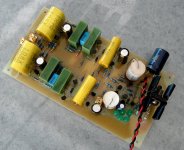I don't really mind the buffer, it allows me to put a fixed impedance on the output of the SRPP and get low distortion and all the gain I need for my applications. In turn, the buffer will drive any reasonable RIAA network. I still want to get the PN4393 cascoded SRPP to display results as good as a lowly PN4303.
I'm well aware of the "clamshell" type ZIF sockets for expediently testing SOT-23 devices. When I actually feel like dropping the $80 necessary to get one, I'll have it.
I'm well aware of the "clamshell" type ZIF sockets for expediently testing SOT-23 devices. When I actually feel like dropping the $80 necessary to get one, I'll have it.
Andrew - the PN4391 is a high VGS fet. With drain currents of 5ma you can get ~ 5V drain voltage for the device below it. Did you look at the sims? It's the same for real life devices. I test all my 4391s for proper VGS at the specified drain current before I drop them into a project.
Hi,
reading is not the problem...memorizing is
In the last posts I was referring to simple SRPPs not cascoded ones.
As Wrenchone already told, the 4391 are high pinchOff-types that fulfill the requirement for a cascode JFET quite well. The combination of the BF862 (-0.3 to -1.2V Vgsoff) and the 4391 (-4 to -10V Vgsoff) seems to be a particularly good match, allowing for incredible gains, large bandwidth and low THD values.
On the other hand Alex Nikitin has written a paper that claims very good results for certain combinations of just the opposite --higher Vgsoff for the driving JFET and lower Vgsoff for he cascoding JFET.
jauu
Calvin
reading is not the problem...memorizing is
In the last posts I was referring to simple SRPPs not cascoded ones.
As Wrenchone already told, the 4391 are high pinchOff-types that fulfill the requirement for a cascode JFET quite well. The combination of the BF862 (-0.3 to -1.2V Vgsoff) and the 4391 (-4 to -10V Vgsoff) seems to be a particularly good match, allowing for incredible gains, large bandwidth and low THD values.
On the other hand Alex Nikitin has written a paper that claims very good results for certain combinations of just the opposite --higher Vgsoff for the driving JFET and lower Vgsoff for he cascoding JFET.
jauu
Calvin
that is the point I was confirming.Andrew - the PN4391 is a high VGS fet. With drain currents of 5ma you can get ~ 5V drain voltage for the device below it. Did you look at the sims? It's the same for real life devices.
You got good results when you used the correct jFETs in the appropriate locations.
To swap high Vgs devices to low Vgs devices in the cascode is bonkers, but you did that anyway. Then complained the THD went up. What did you expect when you disregard the experts' (Jung and others) advice?
Calvin,
can you give us a link to that Nikitin paper?
Last edited:
On the other hand Alex Nikitin has written a paper that claims very good results for certain combinations of just the opposite --higher Vgsoff for the driving JFET and lower Vgsoff for he cascoding JFET.
jauu
Calvin
Andrew, you didn't get what I was doing. I used the PN4393, a lower Vgs device, cascoded with a higher Vgs device, the PN4391, and got higher THD.
The 4391 and 4393 are different rankings in the same family.
The cascoded THD was not bad at all (most people would crow about it and use it as is), just higher than without the cascode. It could possibly be that the PN4393 needs a little more voltage headroom to properly shine. There are two factors at work. The first is higher bias current (within reason) in the bottom device tends to lower THD. At the same time, higher current in the lower device lowers Vgs in the cascoding device, lowering the voltage headroom for the bottom fet. I intend to spend a little more time in simulation trading off both factors to see if I can get better results in cascode with the PN4393 as bottom fet. If not, I have some yet higher Vgs devices in reserve that would work on top. In fact, I used one in simulation last night to cascode a PN4391 with decent results.
The 4391 and 4393 are different rankings in the same family.
The cascoded THD was not bad at all (most people would crow about it and use it as is), just higher than without the cascode. It could possibly be that the PN4393 needs a little more voltage headroom to properly shine. There are two factors at work. The first is higher bias current (within reason) in the bottom device tends to lower THD. At the same time, higher current in the lower device lowers Vgs in the cascoding device, lowering the voltage headroom for the bottom fet. I intend to spend a little more time in simulation trading off both factors to see if I can get better results in cascode with the PN4393 as bottom fet. If not, I have some yet higher Vgs devices in reserve that would work on top. In fact, I used one in simulation last night to cascode a PN4391 with decent results.
Thanks for the "help". You might as well have cited the Pacific Ocean. For those who really want to know, this is a link to a Vishay app note on jfet current sources that cites the Vgs ratio rule. Of course the same stuff will apply for the SRPP. http://www.vishay.com/docs/70596/70596.pdf
Last edited:
After a little work, I found that you can satisfactorily cascode the PN4393 with the PN4391. It took a little more bias current in the 4393. The circuit is shown here.
BTW, taking into account the 2:1 Vgs guideline, I took a look at the 2SK117, which is similar in gm to the PN4393, but has a lower Vgsoff. They also were cascoded very satisfactorily by the PN4391. One thing I noticed is that there is a sweet spot for the bottom fet drain current in the case of the 2SK117. When increased above that point, the distortion starts to rise. Below that current, the distortion also rises. Whether this is the real deal or a Spice artifact remains to be seen. I didn't try to carry the simulation as far for the the PN4393 circuit - it may do the same thing.
One thing one needs to remember is that these are just simulations and should be used as indicators only, pointing the way to promising circuits that still need to be built and tested.
BTW, taking into account the 2:1 Vgs guideline, I took a look at the 2SK117, which is similar in gm to the PN4393, but has a lower Vgsoff. They also were cascoded very satisfactorily by the PN4391. One thing I noticed is that there is a sweet spot for the bottom fet drain current in the case of the 2SK117. When increased above that point, the distortion starts to rise. Below that current, the distortion also rises. Whether this is the real deal or a Spice artifact remains to be seen. I didn't try to carry the simulation as far for the the PN4393 circuit - it may do the same thing.
One thing one needs to remember is that these are just simulations and should be used as indicators only, pointing the way to promising circuits that still need to be built and tested.
Attachments
I already have a board stuffed with PN4393s in the front end. It'll stay that way for a while, at least until I can hear how it sounds. A few more parts and some power leads, and it'll get power up tomorrow. The 4393s front end amps are uncascoded in this version, as I didn't even start to simulate cascoded SRPP stages until a day or two ago. The second stage uses 2SK30A, though it could have as well used the PN4303.
Interesting point - using a cascoded SRPP gives the lowly 2N5457 series a new lease on life, as the cascode allows them to run off of a fairly high VCC without fear.
Meanwhile, the noise issues in my living room get spookier. It appears that I have very little AC line immunity, as I can hear the noise from turning off my CD player in the speakers. This may be traceable back to the brute-force supply I'm using for my outboard preamp supply, an unregulated open frame supply manufactured by Acme/Standard Power. The filter capacitor on this supply is huge, and it's followed by a capacitance multiplier, then another capacitor, so nothing should get through by that route. However, I think I may have leakage/noise isolation issues with the transformer in that supply.I may try replacing it. I used it for convenience's sake, as it was hanging around - maybe a mistake.
Interesting point - using a cascoded SRPP gives the lowly 2N5457 series a new lease on life, as the cascode allows them to run off of a fairly high VCC without fear.
Meanwhile, the noise issues in my living room get spookier. It appears that I have very little AC line immunity, as I can hear the noise from turning off my CD player in the speakers. This may be traceable back to the brute-force supply I'm using for my outboard preamp supply, an unregulated open frame supply manufactured by Acme/Standard Power. The filter capacitor on this supply is huge, and it's followed by a capacitance multiplier, then another capacitor, so nothing should get through by that route. However, I think I may have leakage/noise isolation issues with the transformer in that supply.I may try replacing it. I used it for convenience's sake, as it was hanging around - maybe a mistake.
Will be nice to see your latest proto and learn how you liked it. Noise in phono stages is not only a matter of hiss. That varies with speaker sensitivity and total system SNR. Its it cloaks resolution after a point. I am not demanding on that matter in the greater scheme of things, there are much more strict goals set by others, but I would roughly say 2nVrtHz for MM and 1nVrtHz for MC are ballparks for modern designs. Also the PSU noise can easily creep in with such designs and takes some local filtering care if its enough.
I think I won't get to the bottom of any RIAA noise issues until I get all the snarky system noise issues fixed. It's a bitch when an amp is quiet as a mouse at work and hums in your living room, which is where you wanted it to sound its best all along....
I do have one of my prototypes in a diecast box at work, waiting until I have some spare time to wrestle with the AP analyzer there. I'm also trying to debug a couple of tube amps, though.
I do have one of my prototypes in a diecast box at work, waiting until I have some spare time to wrestle with the AP analyzer there. I'm also trying to debug a couple of tube amps, though.
Well, the front end of my current RIAA preamp (the one actually sitting in my system - I have 2-3 others lying about waiting their turn) uses a cascoded 2SK170, and though it sounds very nice, I'm not getting much low-noise joy therefrom. I have to solve my power supply/grounding issues, and I suspect a rewiring of my turntable and tonearm is also in order.
- Home
- Source & Line
- Analogue Source
- JFET SRPP RIAA Preamp


